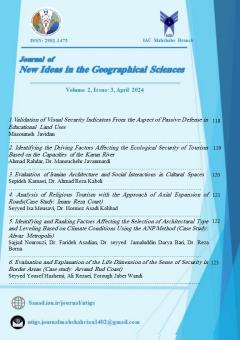Validation of Visual Security Indicators From the Aspect of Passive Defense in Educational Land Uses
Subject Areas : Geography and Passive Defense
1 - M.A., of Geography and Urban Planning, Mahshahr Branch, Islamic Azad University, Mahshahr, Iran
Keywords: Validation, safety, educational landuse, passive defense, elementary schools.,
Abstract :
Increasing the security and safety of schools, reducing their vulnerability, and improving their sustainability are among the factors that increase the psychological security of students and families. It is one of the goals and crucial components of passive defense. Thus, given the significance of the subject, this study focuses on the validation of security and safety indicators from the perspective of passive defense in educational land uses, focusing on elementary schools in the western district of Bandar Imam Khomeini based on the five selected indicators(architecture and design, structure, facilities, proximity and access, and equipment) and 42 sub-indicators. The study type was applied and its method was survey-evaluation with emphasis on questionnaire. The statistical population of the study includes all principals, assistants, teachers, and some experts from the education department of Bandr Imam Khomeini City. The sample size was 117 people. To examine the normality of the data distribution, the Kolmogorov-Sminrov test was used. Also, to examine the status of the research variables, structural equation modeling by partial least squares (PLS) method and SMARTPLS software were used. The results of the PLS test revealed that the equipment indicator with an impact factor of 0.918 has the highest value and the proximity and access indicator with an impact factor of 0.771 has the lowest validity among the study indicators.
1.ابوسعیدي، علی (1391). بهسازي و مقاومسازی لرزهای ساختمانهای بتنی. اولین کنفرانس ملی صنعت بتن، مرکز بینالمللی علوم و فنّاوری پیشرفته و علوم محیطی، 17-29.
2.امانپور، سعید، محمدیدهچشمه، مصطفی، و پرویزیان، علیرضا (1397). سنجش آسیبپذیري مراکزآموزشیاز منظر پدافند غیر عامل(مطالعهموردي: مدارسابتدائیکلانشهراهواز). فصلنامهجغرافیا و مطالعات محیطی. 7(27)، 43-60.
3.ایرانمش، لیلی، وجمشیدی، کیمیا (1395). تحقق اهداف پدافندغيرعامل دركاربريهاي آموزشي با تاكيد بر طراحي فضاهاي باز. ماهنامه شباک، 2(11)، 15-25.
4.حسینی، سیدبهشید، بیطرفان، مهدی، حسینی، سیدباقر، و هاشمیفشارکی، سیدجواد (1394). ارزیابی بازشوی همساز با معماری پدافند غیرعامل با بهره گیری از روش تحلیل سلسله مراتبی. ماهنامه فنی-تخصصی دانش نما، 24(242)، 73-81.
5.رزمی، حمیدرضا، وغلامی، میلاد (1399). واکاوی اصول و رهنمود های طراحی معماری مدارس از منظر پدافند غیرعامل. فصل نامه معماری شناسی. 3(17)، 1-16.
6.زارعزردینی، علیرضا، احمدوند، علیمحمد، و احمدوند، مسعود(1398). کاربرد پدافندغیر عامل در طراحی و اجرای فضاهای آموزشی. اولین کنفرانس بین اللملی مهندسی عمران، معماری و بازآفرینی شهری، شهریورماه، مرکز همایش های بین المللی امام خمینی(ره)،13 صفحه.
7.سامانه سناد وزارت آموزش و پرورش(1401).
8.شهرداری بندرامام خمینی(1400). اداره دفتر فنی و امور نقشههای شهری.
9.عطائیکاریزی، عادل، و نوحیبزنجانی، محبوبه (1399). ارزیابی طراحی معماری مدارس با رویکرد پدافند غیرعامل (نمونهموردی: مدرسهمتوسطه امامحسین(ع) شهرمشهد). فصلنامه معماریشناسی. 3(16)، 1-11.
10.محمدابراهیمی، مهشید، اشنویی، امیر، شایان، محسن، و سالارنژاد، محمد (1401). ارزیابی و تحلیل آسیب پذیری شهریار منظرپدافند غیر عامل(نمونه مطالعاتی: شهر زادهدان). فصل نامه پژوهش و برنامه ریزی شهر،13(48)، 69-86.
11.ملکی، سعید، وگودرزی، رزیتا (1397). ارزیابی وضعیت آسیبپذیري ساختمانهایآموزشی(مدارس ابتدایی) شهر بروجرد. فصلنامه جغرافیا و برنامهریزی شهری چشم انداز زاگرس، 10(37)، 129-151.
12.مولوی، شیما، وخالوندی، زهره (1398). بررسی نقش پدافندغیرعامل درطراحی مدارس. دومین کنفرانس ملی عمران و معماری در مدیریت شهری قرن21، خردادماه، تبریز، 12 صفحه.
13.مهدینیا، سیداحمد، احمدی، محمدجواد، ونقیپور، عبداله (1399). نقش هندسه معماری با رویکرد پدافند غیر عامل. نشریه شهرتابآو، 2(1)، 23-36.
14.یزدانی، محمدحسن، و فیروزی مجنده، ابراهیم (1395). سنجش عدالت فضایی در توزیع مکانی کاربری های آموزشی شهر اردبیل. فصل نامه برنامه ریزی فضایی، 6(3)، 17-35.
15.Alexander, D. (2007). Disaster Management: From Theory to Implementation, Journal of Seismology and Earthquake Engineering,9(1,2), pp. 5-49.
16.Hewitt, B. (2017). An attack on one school is an attack on all schools, A World at School.
17.Robert, J., Geller, I., Leslie, R., Janice, T., Nodvin, W., Gerald, T., & Howard, F .(2007). Safe and Healthy school Environments.Pediatric Clinics of North America. www. epa. Gov /schools /siting/ resources, 54(2),pp.351-373.
18.United Nations Development Programme. (2004). Reducing Disaster Risk: A Challenge for Development. A Global Report, New York: UNDP –Bureau for Crisis Prevention and Recovery (BRCP), available at http://www. undp. org/ bcpr/disred/rdr.htm.


